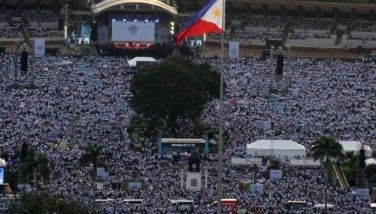Balangiga commemorates Massacre centennial
September 29, 2001 | 12:00am
It is ironic that while the whole world was aghast at what took place in the World Trade Center Towers last September 11, Balangiga, Samar commemorated its worst horror experience during the Filipino-American war. What took place in Samar has been immortalized in a book by the Texan author Joseph L. Schott entitled The Ordeal of Samar.
The Battle of Balangiga has been described as the "worst single defeat" of the U.S. military force in the Philippines. U.S. troops belonging to Company C, 9th Infantry Regiment were stationed in Balangiga. Their mission was to keep its small fort to cut the Filipino revolutionary forces of their supplies. Then hundreds of native fighters, some disguised as women, attacked the American troops while they were having breakfast. Their main purpose was to recover the food stock that had been confiscated from them and to release about 80 male residents who had been rounded up for forced labor. The ringing of the church bells marked the signal to attack. Thirty-six American soldiers got killed. The Filipinos had 28 fatalities.
As a result, Brig. Gen. Jacob H. Smith issued the following instructions:
"I want no prisoners. I wish you to kill and burn, the more you kill and burn the better you will please me. I want all persons killed who are capable of bearing arms in actual hostilities against the United States.
"I want to know the limit of age to respect, sir," his officer asked.
"Ten years," Gen. Smith said.
"Persons of ten years and older are those designated as being capable of bearing arms?"
"Yes."
This was because it was claimed that many of the attackers at Balangiga had been boys of that age.
Gen. Smith was court-martialed and sentenced "to be admonished by the reviewing authority." The court excused its leniency by saying that Gen. Smith "did not mean everything that his unexplained language implied." Pres. Theodore Roosevelt approved the sentence, but he retired Gen. Smith from active service. Thus, Gen. Smith ended his career in disgrace.
Today, there’s still a battle over the historical event in Balangiga. But it is over the bells that marked the signal for the attack. The Philippine government, through the people of Eastern Samar and the House of Representatives have filed a class suit against the U.S. government for the return of the Balangiga bells.
The Battle of Balangiga has been described as the "worst single defeat" of the U.S. military force in the Philippines. U.S. troops belonging to Company C, 9th Infantry Regiment were stationed in Balangiga. Their mission was to keep its small fort to cut the Filipino revolutionary forces of their supplies. Then hundreds of native fighters, some disguised as women, attacked the American troops while they were having breakfast. Their main purpose was to recover the food stock that had been confiscated from them and to release about 80 male residents who had been rounded up for forced labor. The ringing of the church bells marked the signal to attack. Thirty-six American soldiers got killed. The Filipinos had 28 fatalities.
As a result, Brig. Gen. Jacob H. Smith issued the following instructions:
"I want no prisoners. I wish you to kill and burn, the more you kill and burn the better you will please me. I want all persons killed who are capable of bearing arms in actual hostilities against the United States.
"I want to know the limit of age to respect, sir," his officer asked.
"Ten years," Gen. Smith said.
"Persons of ten years and older are those designated as being capable of bearing arms?"
"Yes."
This was because it was claimed that many of the attackers at Balangiga had been boys of that age.
Gen. Smith was court-martialed and sentenced "to be admonished by the reviewing authority." The court excused its leniency by saying that Gen. Smith "did not mean everything that his unexplained language implied." Pres. Theodore Roosevelt approved the sentence, but he retired Gen. Smith from active service. Thus, Gen. Smith ended his career in disgrace.
Today, there’s still a battle over the historical event in Balangiga. But it is over the bells that marked the signal for the attack. The Philippine government, through the people of Eastern Samar and the House of Representatives have filed a class suit against the U.S. government for the return of the Balangiga bells.
BrandSpace Articles
<
>
- Latest
- Trending
Trending
Latest
Recommended




























